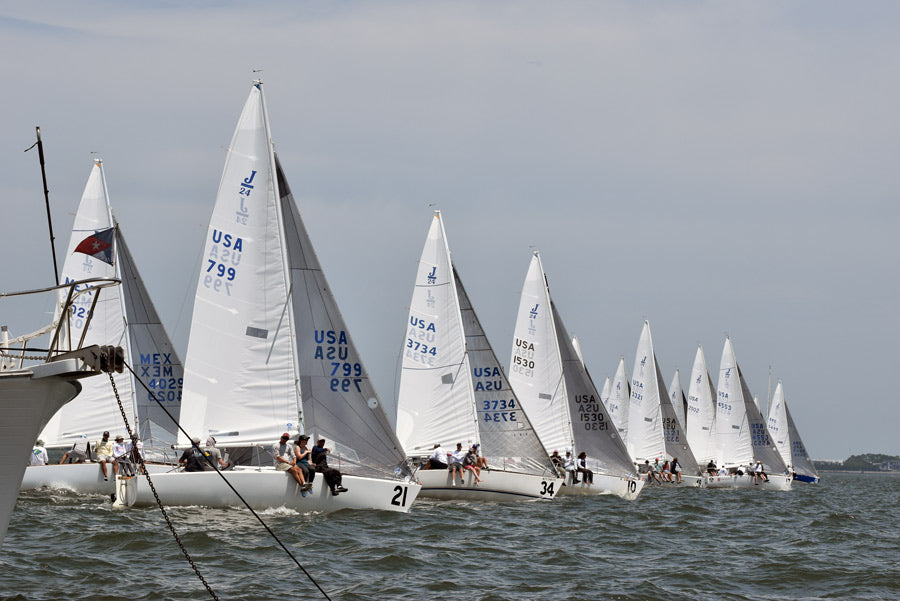J24 SPEED GUIDE
J24 World Champion Will Welles answers your speed and boathandling questions.
After 40 years, what is the culture of the J24 class?
The J24 class has changed over the years since it was first launched in the late 1970s. It remains strong because with 5500 boats worldwide, it’s relatively inexpensive. You can fix up a 1978 boat and win the worlds if you put in the time, energy and a little money. There are fewer pros racing, and a lot of the competitors are people who have been in the class for a long time. Many grew up sailing with their family and friends in the boats and love nothing more than going to regattas together. For younger folks, it’s all about sailing with their buddies—a chance to head off on the road and experience the country and the world. Sailing with five has a bit different feel than classes with fewer in the crew. More people to manage makes it, a mini big-boat program.
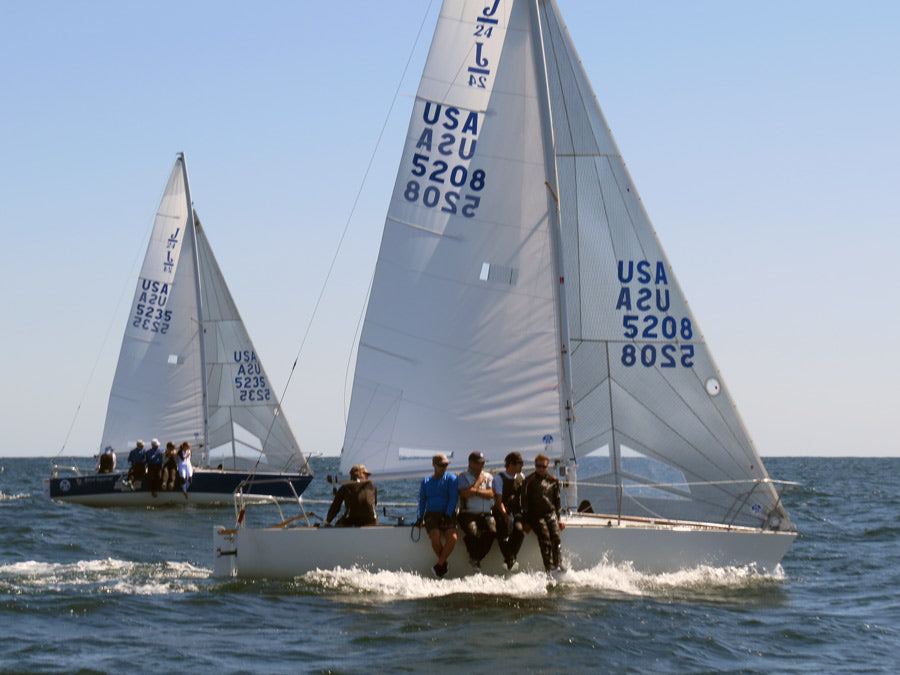
J24 sails upwind fastest with minimal heel and crew weight concentrated.
Winning the world championship still means a lot in this class, and it’s remarkable how people come out of the woodwork to try to do that. At the club level, racing is as healthy as it’s been in some time. Certain areas are doing better than others, like any mature class. Portland, ME has lots of boats, none of them dry-sailed. In the U.S., there are a dozen strong fleets and lots of smaller fleets; for example, there’s a growing fleet in Indiana. Mexico and South America are pretty strong, although there has been some transition to J70s. Strong J24 countries in Europe include Italy, Germany, Sweden, Greece, Hungary, the UK, Ireland, and France. In Germany, a lot of boats are owned by clubs that fund youth teams.
What kind of sailors do best in the J24 class?
The J24 is unlike many other boats, so having some seat-of-the-pants ability is good; for example, there is no other boat on which you trim the main so hard and pinch, with a bubble in the genoa, when you are overpowered in flat water.
What are your top 3 tips for competing successfully in this class?
-
Buy a boat with the right keel shape, mast, and deck layout.
-
Maintain a good set of sails.
-
Assemble a team that’s committed to the same goals as you.
Who does what on the boat?
Back to front, the helm steers, trims the main, and plays the traveler and backstay. The helm also grinds the jib winch. The trimmer handles the genoa and often handles the spinnaker sheets. What we call the “tank commander” (middle position) is often the tactician; ideally this person is one of your heaviest team members, hiking at max beam. Their job includes handling the guy on a windy spinnaker set, feeding the spinnaker out on a light-air set, and taking down the spinnaker. The mast/twing person controls the twings and backs up the bow person on halyards, outhaul, main cunningham, and vang. The bow person skirts the genoa on tacks, handles the pole, and hoists the spinnaker and jib.
What is the ideal J24 crew size?
The crew-weight maximum on the J24 is 882 pounds (400 kilograms). You don’t have to sail exactly at max weight unless it’s a windy venue—you can often handle being 20 pounds lighter. The average crewmember weighs about 175 pounds. Ideally, your heaviest crew is amidships, but it’s not important for the bow person to be light. Both bow and trimmer need to be strong for heavy air. The J24 has a genoa that requires speed and strength on tacks—trimming on tacks is all about timing, but strength is important too. On some boats, the mast person helps jibe the pole.
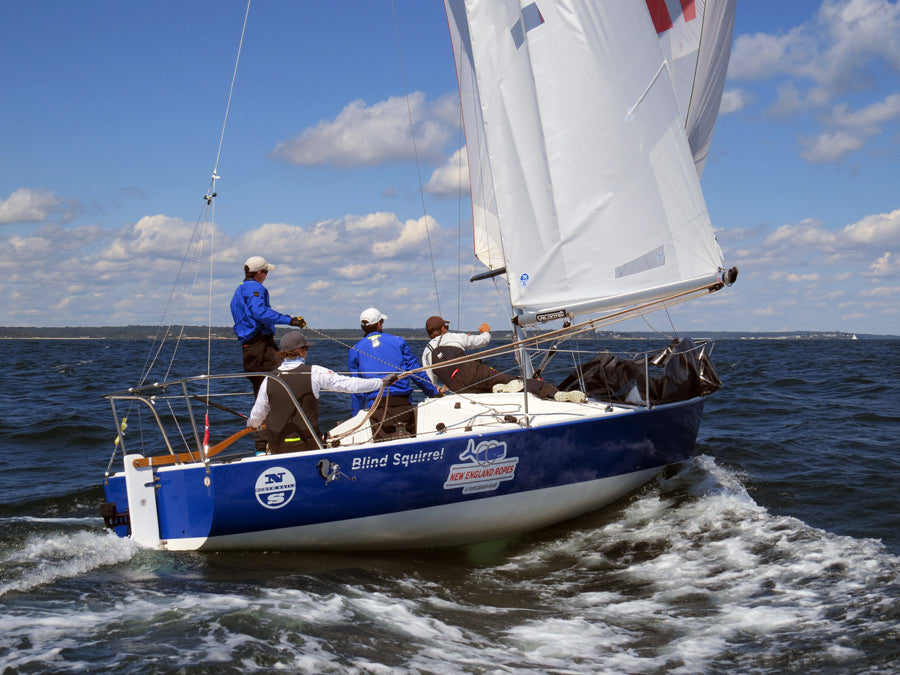
The crew moves in concert to help turn or steer the boat, especially in waves.
New boats and used boats: what are my options in the J24?
The class currently has two builders, one in Italy and one in Argentina, and you can reach them through the class website.
Used boats, of course, are plentiful and the prices are modest. For a worlds-quality boat with trailer in the U.S., you’ll likely spend $10,000- to $12,000. A weapon might cost about twice that. If you want a fixer-upper, you can get into a boat for well under $10,000.
Things I would look for are a refined keel shape and faired bottom, a relatively new rudder, and a newer mast. Look at the deck hardware, and inspect both the chainplates/bulkhead and rudder gudgeon areas. If you buy a boat that’s been competing at a good level, you can expect that the spreader sweep, keel shape and position, and rudder angle will already be right.
How do you transport the J24?
Boats have dedicated trailers, which together with the boat weigh about 4500 pounds. The boat at all-up racing weight is 1330 kgs, or close to 3000 pounds. The trailer and trailer boxes add about 1500 pounds. Most used J24s have trailers; some are single-axle. Double axles are nicer for longer distances.
What's involved in rigging/derigging a J24?
If you’re well organized, two people in an hour can get the mast unpacked, stepped, tuned, and boat ready to launch. Derigging is similar, or even quicker. The boats are set up for a single-point lift through an inspection port on the seahood. Add a couple lines from the strap to each of the aft cleats and you’re set to launch.
What kind of inventory does North recommend?
We recommend a fathead main, currently our only mainsail design, and the most popular headsails we sell are the DX7TT genoa and FR2 spinnaker used by the winners at recent world championships. We have an option for a slightly flatter genoa, which might be chosen by a lake sailor, and we have a second spinnaker that is harder to trim but excels in windy, wavy conditions.
North also makes some nice covers—a full deck cover for storage in a drysail park or in your yard, and a full mast cover. We have a padded rudder cover for below-decks storage and a padded keel cover for trailering. We also offer a nice spinnaker launch bag that hangs in the companionway.

The standard deck layout is set up for cross sheeting of the genoa sheet; the helm can reach the winch handle when trim is needed.
J24 Tuning
What is the most important boat preparation project to address on the J24?
To quote the North Sails Tuning Guide, “Sails, deck layout, keel and rudder shape, and mast tuning all share equal importance. To be competitive in the J24, you must tackle all of these important factors.” Fortunately, as described above, if you buy a boat that’s been competing at a good level, most of these will be in good shape already. But don’t take it for granted. Read the Tuning Guide and see how your boat measures up.
What are the keys to tuning a J24 mast properly?
First thing, make sure your mast is at minimum legal height, and at maximum class J dimension, and the headstay is at maximum length. This combination helps rake the mast aft and eliminate lee helm. Next, make sure your spreader sweep is at 160 to 170 mm, measured from a straight line between the tips to the mast groove. Then make sure mast is centered in the boat and straight. From there, use the tuning matrix in the North Tuning Guide to set correct shroud tension.
J24 Upwind Sailing
There are two jibs on a J24. When do you switch from the genoa to the blade?
It seems to be the “macho thing” in some fleets to keep sailing with the genoa in higher winds. If I’m sailing at maximum weight, I will switch to the blade at 16 knots and above in flat water. In waves, you can’t go there until it’s blowing above 18. If you’re sailing really light, you may have to change headsails earlier.
Where does each person sit when sailing upwind?
In light air, we like “dogs in the house” (crew members sitting below). There is no rule against it, and it’s more comfortable down there. The bow person sits in the V berth in front of the mast, to leeward. The mast person sits just behind the mast on the sink or on the floor. The tactician and the trimmer might be below, as well. The trimmer often sits to leeward and sticks their head out once in a while, but the tactician will normally be the first person to look around to help the skipper place the boat where needed. The skipper sits forward of the traveler, to windward, for best visibility.
As the breeze builds, we gradually move each crew on deck until everyone is hiking. First to come out is the tactician, then the bow person, then mast. The trimmer is the first to move in and last to move out of the hole. Under 6 knots, we have everyone below; at 7 knots, people start to come up. At 10, everyone is fully hiked.
In flat water, one body hikes in front of the shrouds from 7-10 knots and everyone else packs up tight behind them. As the breeze and waves build, crews move behind the shrouds but stay close together. In heavy air and big waves, the trimmer sits just behind the stanchion and everyone else packs up against the forward side of it. At the helm, once everyone is hiking, I’ll start pulling on backstay. I straddle the traveler bracing on the footrests. My butt is outboard and my shoulders are pressed against the lifelines.
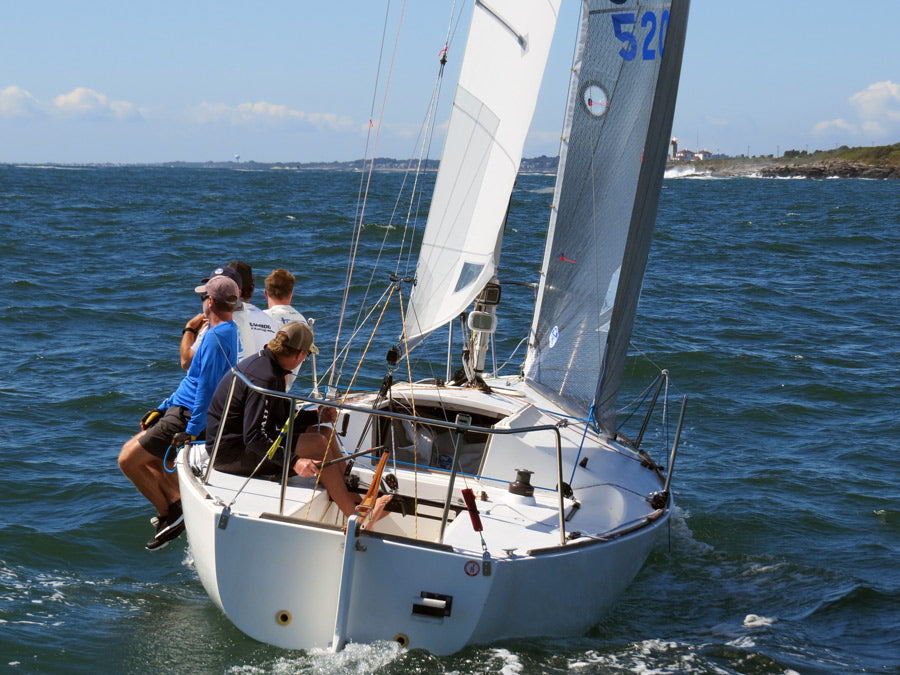
In light to moderate air, the main traveler is sheeted well to windward. The genoa foot and leech are trimmed within a few inches of the chainplates and spreader tip.
What is your primary focus when trimming the mainsail?
When sailing upwind, focus on the top leech telltale and how it’s flowing. Look at the next one down, too. You never want the second one stalled. When the keel is working and we’re fully hiked out, I’ll trim the main hard enough to stall the top telltale 50 percent of the time. When we’re losing speed or need more power, I’ll ease a little sheet so the top telltale is flowing 100 percent of the time, and once we’re back up to full speed I’ll trim harder. This amounts to a couple inches of mainsheet adjustment in 8- to 12 knots. In lighter air, the top telltale should be flowing 100 percent of the time and the traveler car should be all the way to windward, over the Delrin traveler end stop.
Tighten the backstay after the crew is fully hiked. When that’s not enough to keep the boat flat, drop the traveler down six inches. When you run out of backstay, shift to vang sheeting, which you can use up to as much wind as you’ll race in. Drop the traveler car down until it is one car width above the center of the traveler, have two crew pull on the vang as hard as possible so there’s a bow in the boom, and then adjust the traveler to keep the boat on its feet through the puffs.
What’s your focus when trimming the J24 genoa?
J24 genoa trim is measured by the distance between the leech and the spreader and the foot position relative to the leeward chainplate. We set the lead so both leech and foot touch at the same time, then ease the sheet as follows:
-
In light air, the leech should be 5 to 10 inches off the spreader until you’re up to speed, then trim to within 3 to 5 inches. In puffs and lulls, ease up to 8 inches off. Out of a tack, start at 18” and then trim as the boat gets up to speed. In medium air, the range is 2 to 6 inches off the spreader.
-
In breeze, you need to manage your angle of heel. Trim to within 2” of the spreader, but if it’s windy enough that you are vang sheeting and still heeling over in the puffs, ease the genoa sheet—you might be easing it out a foot in the puffs, then trimming it back in. In flat water you can feather and pinch, but in waves you have to ease more often. It’s all about reducing heel.
Switch to the blade jib when the wind is 16 to 18 knots and above. Trim the sheet until the leech telltale stalls, then ease enough to fly it 100 percent of the time. The middle of the sheave on the lead block should be even with the chainplate.
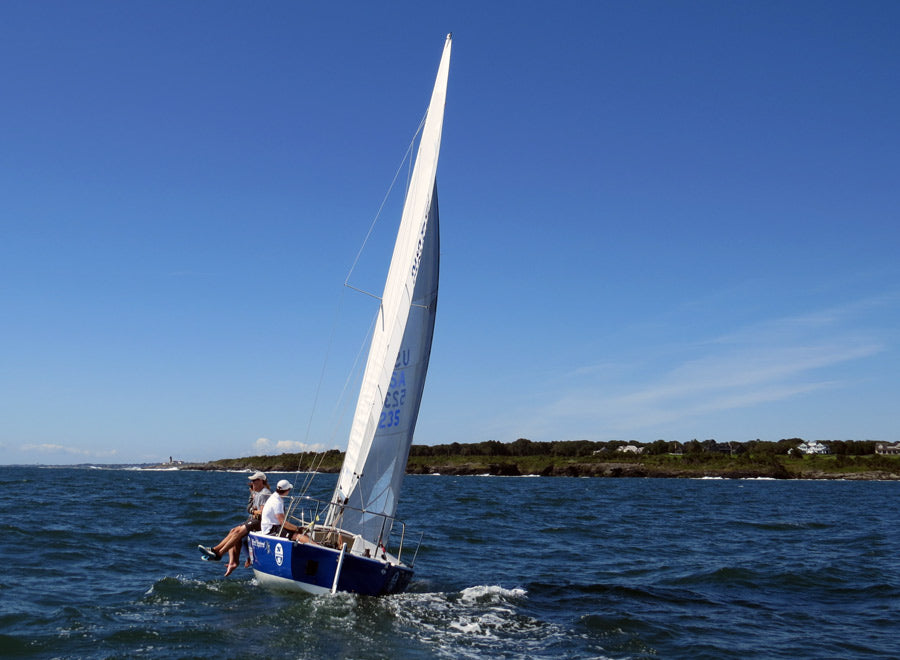
A good view of well-matched leeches in moderate air.
What are the key J24 gear changes to make when wind and sea state change?
Positioning your crew weight is huge in light to moderate conditions. Play the backstay in medium air. And in heavy air, it’s all about proper sheeting. With the genoa, you play the sheet a lot more and see the biggest speed differences. Learn to manage your angle of heel, and get comfortable with sailing the boat flat. Then you can win races.
Who is in the typical dialogue loop upwind and what's a typical conversation?
The more you sail the J24, the less you have to talk. I like minimal words but to be alerted to extremes, like “Nuker puff coming.” I also like hearing about the lulls and how long they’ll be—10 seconds or 30 seconds—so I know whether to just pop off the backstay or make a longer-term adjustment. For example, I may talk to the trimmer about easing the genoa and ask how our mode is with other boats—do we have good height, good forward speed? We always talk about “us.” Are we slower, faster, higher, lower? We usually leave boat placement calls to the tactician; we do our homework together between races, but then the tactician makes it happen.
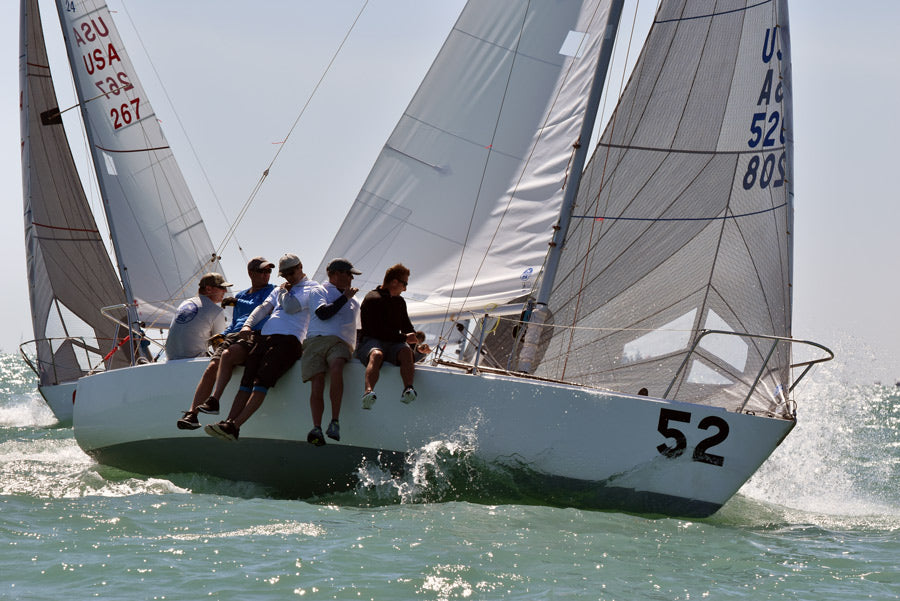
When sailing upwind in breeze, the crew of five hikes hard. Christopher Howell photo
Are there special considerations or upwind conditions in the J24 a new sailor should know how to handle?
You have to learn to keep the boat flat by any means possible—crew weight, depowering, pinching, more backstay, more shroud tension.
J24 Downwind Sailing
Where does each crew member sit when sailing the J24 downwind?
In 4 or 5 knots of wind, we might have everyone below except the trimmer and helm. The bow uses the forward hatch. The mast person sits in the sink area, the tactician stands in the companionway, and the trimmer stands up on deck. The helm sits to leeward and forward of the traveler.

Downwind, most of the crew sits low and forward; the trimmer stands up.
As the breeze comes up to 7 knots and above, everyone comes on deck unless there are big waves, in which case we might keep a couple crew below. The boat should be flat or slightly heeled to weather, with weight to the edges for stability. Exact location varies with crew weight, but typically the bow is in front of the mast, either to leeward or to weather as needed. The mast person sits out toward either rail. The tactician stands on the cabin sole in “tank commander” position. The trimmer stands out at the toerail by the weather stanchion. We move our body weight to help steer the boat; in light to medium breeze, the bow person watches the tiller and listens to the dialogue, moving weight accordingly. In heavier air, both mast and bow are moving.
When it gets breezy, the boat can get a little out of control in waves. Bring the crew weight behind the mast and to leeward to keep the weather rail up, so that the boat wants to go straight; otherwise the bow goes down, you lose the rudder and wipe out to windward. If planing (30-plus knots), everyone gets behind the traveler. In medium or heavy air, I sit behind the traveler and to leeward unless we are planing; then I’ll sit to windward or stand up in the middle. In any waves and in medium and heavy air, I always lock the tiller extension in place and steer with the tiller downwind to reduce my reaction time.
What are the key changes in different conditions?
As wind and sea state build, start moving the crew aft, keeping always to the edges except for the tactician, who stands on the cabin sole. Never heel the boat to leeward except in light air when you want to head up. Always err towards sailing the boat flat or with slight weather heel, because that will help project the kite and balance the helm.
What do you focus on when trimming main and chute?
The main goes all the way out downwind and we never ease the outhaul unless we’re reaching. I sit to leeward and hold all of the purchase parts. I never want the main luffing or over-trimmed. Adjust the vang to keep the top batten parallel to the boom.
Adjust the spinnaker pole height and work hard to square the pole as much as possible. Always play the sheet out to the curl. If we’re sailing angles (less than 8 knots), we’ll set the tack slightly lower than the clew for better flow across the chute. In 8 knots and above we make the clews even, square the pole back, and go dead downwind. The J24 has two pole settings; we use the bottom ring up until 16 knots, then switch to the top.
Downwind, who is in the typical dialogue loop and what's a typical conversation?
The trimmer and I talk constantly about wind pressure in the kite, especially in light to medium air. Once the wind becomes medium/heavy, the bow warns us about big puffs so we don’t get caught with the bow too low.

To catch a wave, the helmsman and trimmer pump the sheets in unison, and the crew presses against the windward rail.
What controls are important downwind in different conditions?
We let the backstay all the way off downwind, unless the wind is 20 knots or more; then we leave half of the backstay on. Two other things we recommend when the wind is above 20 knots: pull the vang on extra hard to stabilize the boat, and pull both twings down to choke the kite a bit. We always use the foreguy, and unless it’s above 20 knots we trim the weather twing so it’s halfway from lifeline to rail and let the leeward twing off all the way. Also, when we’re sailing upwind with the blade jib, we’ll typically leave it up downwind. It helps stabilize the boat, and you can trim it like a staysail when planing.
J24 Boathandling
What's a start like in the J24 class?
Normal procedure is for teams to drop the genoa between races and hoist again with 4 or 5 minutes to go. Velocitek instruments are legal now, so you can ping each end of the line and have a reliable GPS-measured distance to the line. It’s made starts even more aggressive.
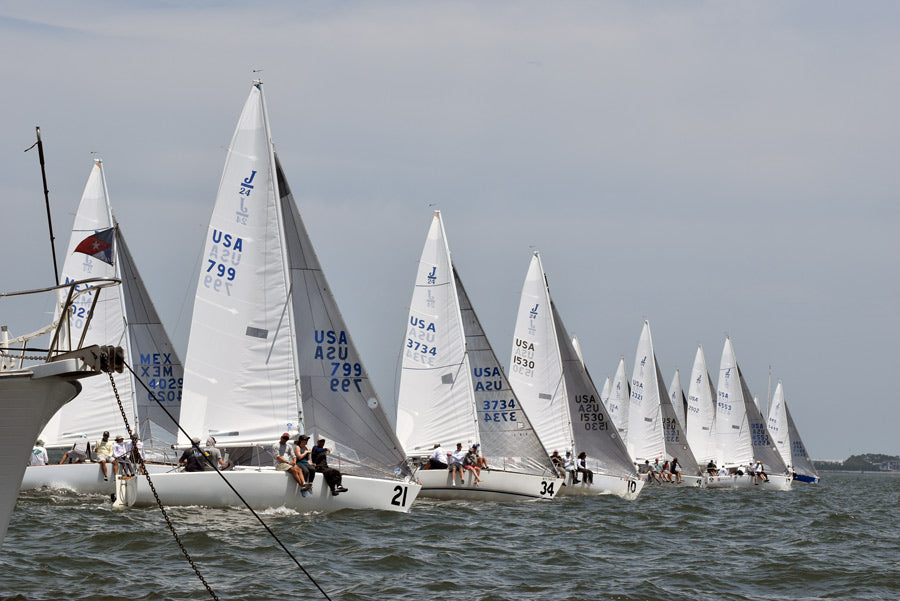
A competitive J24 start shows four crew hiking on most boats and mainsail luffs eased to keep the draft aft, well-matched for the genoa overlap. Christopher Howell photo
What tips can you offer for starting well in a J24?
Always have a routine and stick to it. You always need a plan B but if you have a routine, everyone knows what to expect. On our boat we’ll get windshots, figure out the favored end, and decide which side we want to sail on the first beat. Then we’ll block out a section of the line where we want to start. It’s up to me to get the boat there.
I’m a port-tack approach guy; I’m watching the clock and trying to figure out where I need to be to get to that place on the line by one minute. J24s can stop and get going quickly, so my goal is to be tacking into a good hole at about one minute. I’m always looking for real estate—whole pockets where boats aren’t. Once you find your hole, manage the people around you.
The bow keeps us honest about distance to the line, using hand signals. The bow can also lift the skirt of the sail with the foot line to help visibility.Time comes from the middle crew; I like it loud, counting down the last 30 seconds. The trimmer listens to my requests for “full speed, half speed, stop.” The tactician watches out for “snipers” (boats behind) and reminds me when it’s time to go.
What tips can you offer for downspeed boathandling?
Practice your starts. Get the crew out for an evening, pick your marks, and do time-on-distance exercises.
What mistake slows the J24 down most in a tack?
Genoa trim is the one of the top three priorities in tacking the J24. The helm should use a moderate rate turn and be consistent. The biggest thing that slows you down is if the trimmer doesn’t release the genoa sheet soon enough and you “smoke” the back of your sail (against the windward spreader and shroud). Most trimmers release it too late; you need to release by the time the bow gets head to wind, or even slightly before that. This also makes it easier to trim the new sheet. I like the bow person to grab the foot and help the sail around the shrouds.
What does each crewmember do when tacking a J24?
The skipper is busy, first removing the winch handle and putting it into the winch-handle pocket, then turning the boat and bringing up the traveler, plus usually easing the mainsheet two inches and sometimes burping the backstay. Finally, they put the winch handle in, pull on the backstay and main, and grind in the last bit of genoa sheet.
The trimmer cross sheets the genoa, releasing the old sheet by the time the bow gets head to wind, trimming the new sheet and then hitting the rail with sheet in hand, leaving the final grind to the helmsman. The bow handles the foot line on the way across the boat in front of the mast.
The other two cross the middle of the boat, roll tacking the boat if possible. I might say, “1, 2, or 3 roll.” (The tactician is 1, the bow guy is 2, and the mast guy is 3.) The mast is the worst position to roll from because they need to go under the foot of the genoa on the way to windward. Sometimes we vary this depending on the wind, and another reason might be if the tactician is heavier and you want them to get to the windward rail faster.
Any tips for good light or heavy-air tacks?
Roll tacks are crucial in light air. Also, make sure the mainsheet is eased a little so you can get back up to speed quickly. In heavy air, the mainsheet needs to be eased to avoid heeling too much.
What is the key to a fast spinnaker set?
Timing is critical to a good J24 set. Make a good pre-feed of the tack, and have the bow person tension the footline to keep the jib inside the lifelines and out of the way. Trim the main and genoa on the offset leg while the pole is going up. Get the kite out of the boat and up. Don’t ease the main out all the way until the chute is out and clear of the leeward spreader.
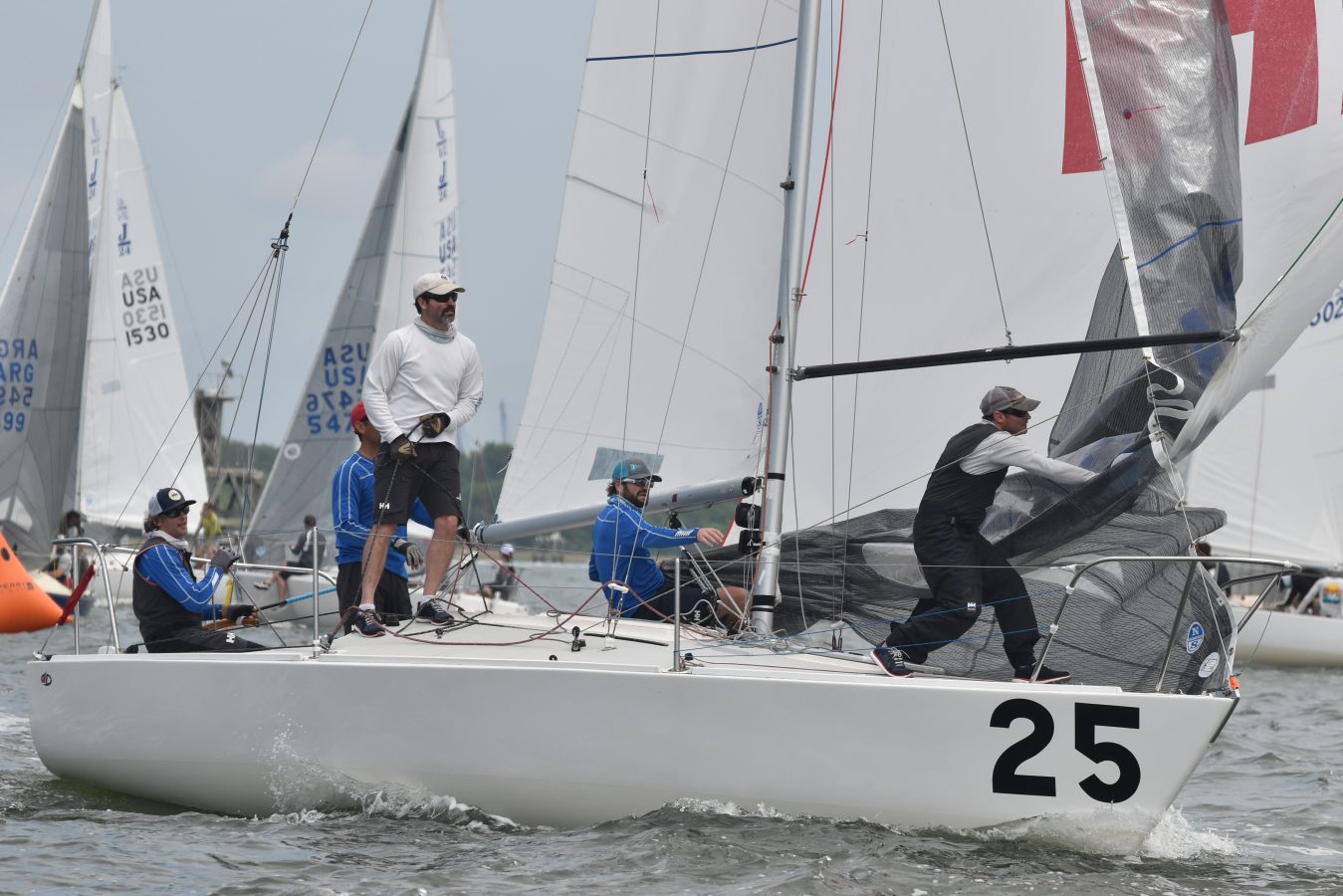
Dropping the genoa quickly is important after the spinnaker is set and flying. (Christopher Howell photo)
Who does what on the J24 during a jibe set?
The debate is always whether to go with pole or no pole. I like to do a jibe-set with the pole up because it doesn’t telegraph your move, and it helps keep the kite away from the boat. Ideally, the kite goes up and the boat turns and you do a late jibe with the pole. As the pole comes across, the mast person lets the genoa down. Don’t rush dropping the genoa, or it will foul up the spinnaker. The tactician should be ready as a human pole on the new jibe. Our priority is to get the kite filled on the new jibe; if we can get the genoa down, great; but if not just make sure to ease the sheet.
What mistake slows the J24 down most in a jibe?
Don’t over-steer the boat. In any breeze, you lose distance and heel a lot. Match the rotation of the spinnaker to the rate of the turn. In lighter air, it’s possible to understeer and come out too low, so the boat loses speed and/or the kite collapses.
What does each J24 crewmember do in a jibe?
In 8 to 10 knots, the helm turns the boat, the trimmer rotates the kite holding both sheets, the bow jibes the pole, the mast does the twings, and the tactician moves from one side to the other. Everyone works together to roll the boat in light and medium conditions.
Key tips for good light or heavy-air jibes?
In light air, roll the boat through the jibe. The helm must come out of the jibe on an angle with adequate pressure to fill the spinnaker, while the trimmer crosses the bridgedeck to the new windward side after ducking under the boom.
In heavy air, it’s key for the helm to keep the bow under the logo in the foot of the spinnaker. Stray from that and you’ll probably wipe out. Jibe the main on top of a wave or when the boat unloads, with somebody forward helping the main across by grabbing the vang. In super heavy wind when you have your crew weight aft, have someone else jibe the main.
What is the key to a good spinnaker takedown?
Practice makes all the difference on the J24. Have your boat settled and set to go upwind when you round the mark. The better you get at takedowns, the longer you can keep the chute up.
Who does what in the crew on a windward or leeward takedown?
The bow ditches the foreguy, raises the genoa, and then takes off the pole (replaced by a human guy) and drops it to the deck, clipping it onto the shrouds under the genoa sheets. Then either I call the takedown, or if there’s traffic, the bow person makes their own call. If the bow needs help, the mast douses the halyard.
The middle person acts as the human pole (sometimes it’s the mast person) and pulls the kite down into the companionway. The jib trimmer under-trims while rounding the mark so we don’t lose speed. I trim my own main, with a preset traveler and backstay. In traffic, I might set up with less backstay.
Any special takedown tricks in this class?
Dropping the halyard six feet and holding for a second allows the foot to be pulled in, which makes for a better takedown.
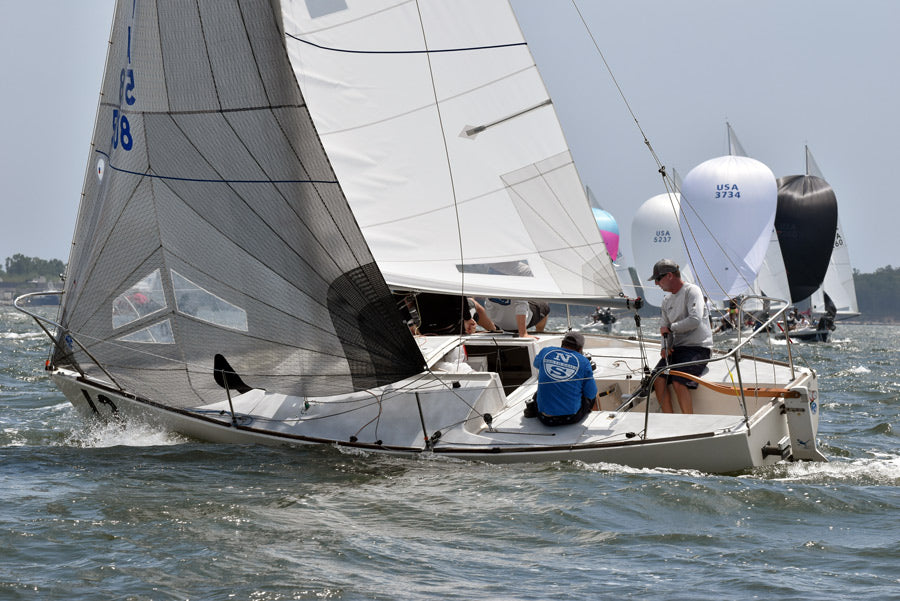
At the leeward mark, genoa trimmer and helm work together to trim the big headsail; the trimmer hauls in while the helm finishes his main trim and prepares to grind. Christopher Howell photo
Doing circles is slow in any boat; what are the keys to minimizing the pain on a J24?
Practice circles, too. We always jibe first. I think it’s faster.
How easily does a J24 broach or capsize?
It’s relatively easy to broach a J24 if you’re not watching for big puffs. And upwind, if you’re not vang sheeting in heavy air, you’re going to wipe out. The boat has a big rudder, but the wide hull shape takes over when you heel.
How do I recover when/if it happens?
When you broach under spinnaker, you can pop the boat back up pretty easily, but if it doesn’t come up right away, blow the spinnaker halyard.
What are the most common boathandling mistakes made in this class?
Not sailing the boat flat enough is the most common error. After that, timing the genoa release on your tacks. I recommend practicing tacks with an old sail.
Any suggestions for drills to improve boathandling?
I like to do two-boat stuff sailing upwind. It’s the best way to learn all the gears. Lots of gear shifting with this boat. The better you get at making sure the boat’s in the right gear all the day, the more successful you’ll be.
What is the coolest thing about the J24?
People are super down to earth, really nice. Most of my best friends are from the J24 class. Everyone helps each other out whether it’s missing or broken boat parts, tuning help, or stepping the mast. Everyone likes to sail pretty hard and enjoy a cold beer after. The average age of a J24 owner is late 30s.
At major events you still see a very high caliber of competition; we get 50 to 60 boats at major regattas and 80 at a Worlds. At the club level, lots of people own the boats and they use them—they’re having a lot of fun.






















